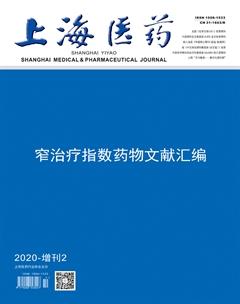《窄治疗指数药物文献汇编》概述

党的十九届五中全会正式提出了到2035年建成健康中国的远景目标,明确了“十四五”时期要实现人民身心健康素质明显提高等目标,充分体现了党中央维护人民健康的坚定决心。为改善人民生活品质、加强合理用药规范,上海医药行业协会在上海市卫生健康委员会、上海市医疗保障局和上海市药品监督管理局的指导下,遵循药品管理的“社会共治”原则,以窄治疗指数药物(narrow therapeutic index drugs,NTIDs)为研究对象,在多位医学、药学专家的大力支持下,探索此类高风险药物的管理及使用规范。
2019年起,随着药物一致性评价和药品带量采购工作的深入开展,有关提升药品质量管理、科学规范用药的问题越来越受到业界关注,其中加强对NTIDs等高风险药物的研究和管理显得更加迫切。上海医药行业协会邀请相关专家梳理资料,并在此基础上发表了多篇学术文献[1-2],制订了《窄治疗指数药物质量评价及标准制订的通用技术要求》团体标准[3]。2020年,国家药品监督管理局药品审评中心发布了《窄治疗指数药物生物等效性研究技术指导原则(征求意见稿)》[4],标志着行业管理部门对NTIDs质量安全的高度关注。
在此背景下,《上海医药》编辑部积极邀请各行业管理部门及专家学者,加强对NTIDs的研究,编撰出版《窄治疗指数药物文献汇编》,希望凝聚更多有识之士的智慧以加強对此问题的研究,携手推进NTIDs的规范管理。下文对NTIDs作简要介绍。
1NTIDs的定义
NTIDs的定义有官方定义和非官方定义(专家定义)两种。官方定义主要来自美国食品药品监督管理局(Food and Drug Administration,FDA)和加拿大卫生部。FDA将用药剂量或血药浓度出现小的差异就可能导致严重治疗失败和/或严重不良反应(危及生命或持续的严重伤残)的药物,称为NTIDs[5];其邻国加拿大卫生部则使用临界剂量药物(critical dose drugs)来表示NTIDs,将其定义为用药剂量或血药浓度出现相当小的差异就会导致剂量或浓度相关的严重治疗失败和/或严重不良反应(可能持续、不可逆转、恢复缓慢或危及生命,导致患者住院或住院时间延长的、持续的严重伤残或死亡)的药物[6]。上述两个定义尽管用词、语气略有差异,但内涵一致。此外,世界卫生组织(World Health Organization, WHO)也给出了类似的定义:NTIDs是特别容易产生不良反应,微小的剂量误差即可能导致灾难性后果的药物[7]。目前以FDA对NTIDs的定义最为常用。非官方定义相对较多,认为治疗指数(therapeutic index,TI)<2[8]或≤2[9]或≤3[10]的药物为NTIDs,也有专家将相当小的血液浓度变化导致明显药效学反应的药物或当生物利用度不变,剂量变化≤20%时,出现明显药效学改变的药物称为NTIDs[11-12]。
2NTIDs的特点
NTIDs是一类特殊药物,通常具有以下特点。①多数NTIDs的TI<2,即按美国联邦法规(Code of Federal Regulations,CFR)第21篇(食品与药品)中所述,窄治疗指数(narrow therapeutic ratio/narrow therapeutic index,NTI)是指药物的半数致死量与半数有效剂量的比值或最小中毒浓度与最小有效浓度的比值<2[13]。TI是药物的安全性指数,越小越不安全。②治疗窗狭窄。治疗窗是指药物的有效浓度范围,即最小有效浓度和最小中毒浓度的范围,如华法林的国际标准化比值(INH)达标范围为2.0~3.0,地高辛的有效浓度范围为0.5~2.0 ng/ml等。③个体内变异≤30%[14]。④用药剂量调整幅度≤20%[14]。⑤需要进行治疗监测。⑥易出现疗效不等(therapeutic inequivalence,TIE)现象(治疗失败或严重不良反应)[15],即具有相同主成分、剂型、剂量及给药途径的药品(包括呈现体内生物等效性的药品)在相同用药剂量及用法下产生的不相等的临床反应,这种不相等的临床反应包括疗效增强或减弱以及产生意料之外的不良反应或不良反应的强度、频率增加。TIE通常发生在替换不同制药企业的相同药品或同一制药企业的不同批号药品时[16],其结果必定影响疾病治疗,延误病情。而且NTIDs的TIE似乎更常见,如2019年第3季度FDA就收到他克莫司胶囊的TIE报告[17]。FDA认为TIE是严重问题,早在1988年9月14日就成立了疗效不等评估委员会(Therapeutic Inequivalence Action Coordinating Committee,TIACC)。目前,尽管对NTIDs仿制药与原研药之间的TIE存在争议,但随着纳入研究样本的扩大,发现确实存在差异现象。如纳入病例数超4万时,结果提示仿制与原研华法林之间具有相等的安全性和疗效[18],当纳入病例达74.6万时,显示使用原研华法林的患者更健康[19]。对多西他赛的多份对比研究结果同样显示,仿制品的安全性问题明显多于原研品[20-27]。因此,FDA认为需要广泛执行更严格的产品质量和生物等效性试验标准来确保仿制NTIDs的安全和疗效。
3NTIDs的品种
尽管各国对NTIDs的认识在不断提高,但仍没有形成国际级的NTIDs品种目录。美国、日本、加拿大和我国都曾推出过各自的NTIDs品种目录,但这些品种目录都未能得到及时更新。如我国的NTIDs品种目录发布时间为2008年,仅列有华法林、地高辛、苯妥英、卡马西平、茶碱、左甲状腺素、他克莫司、克林霉素等30个品种[28]。而许多专业文献资料早已将多西他赛、奥沙利铂等细胞毒性抗癌药、麦考酚酸(酯)、拉莫三嗪等常用药品认定为NTIDs[2,29-31],甚至还发现了一些条件型NTIDs,即在某些特定条件下具有NTIDs特性,如贝伐珠单抗、氟哌啶醇、利培酮等在老年人中属于NTIDs[2]。2018年,已有文献整理并列出了包含123个NTIDs品种的目录[10]。
4NTIDs的使用
NTIDs大多是臨床常规使用的药品,其用药风险远大于非NTIDs[32-33],加上NTIDs的质量问题更加普遍,其用药安全无疑成了关注的重点。目前,亟需制订相应的安全使用措施来防范NTIDs的用药风险,如择优选用NTIDs,谨慎替换不同制药企业的NTIDs,加强NTIDs治疗监测或相关基因检测,不掰分NTIDs口服制剂(剂量规格应多样化),避免NTIDs相互作用等[1]。
NTIDs的安全问题是普遍存在的世界性问题,尤其是仿制NTIDs。2018年发表的针对美国药师的调查[34]结果显示,过半的药师认为仿制与原研NTIDs比较,可能安全、可能有效,信心明显不足。说明仿制与原研NTIDs之间存在真实的差距,这也是许多临床治疗指南或专业人员反对使用NTIDs仿制药替换原研药的主要原因,美国一些州甚至以立法的形式限制药师擅自替换处方中开具的原研NTIDs[34]。目前,我国仿制药质量与疗效一致性评价仍在进行之中,医药界亟需广泛提高对NTIDs质量安全和使用安全的意识,并借此契机,采取执行严格的质量标准、明确NTIDs目录清单、规范化使用和谨慎替换等措施,才有可能保证NTIDs的使用安全。
参考文献
[1]陈志东.窄治疗指数药物的多样性及安全用药建议[J].上海医药,2019,40(13):29-35.
[2]陈志东.窄治疗指数药物安全性的再认识[J].上海医药, 2020,41(19):57-64.
[3]上海医药行业协会.?窄治疗指数药物质量评价及标准制订的通知技术要求?正式发布[J].上海医药,2020,41(11):105.
[4]国家药品监督管理局药品审评中心.关于公开征求?窄治疗指数药物生物等效性研究技术指导原则(征求意见稿)?意见的通知[EB/OL]. (2020-08-03) [2020-11-22]. http:// www. cde. org. cn/attachmentout. do? mothed=list&id= 2ffac9390966118e.
[5]U.S.Food and Drug Administration.FY2015 regulatory sci‐ence research report: narrow therapeutic index drugs[EB/ OL].(2017-05-09)[2020-11-22].https://www.fda.gov/indus‐try/generic-drug-user-fee-amendments/fy2015-regulatoryscience-research-report-narrow-therapeutic-index-drugs.
[6]CanadaHealth. Guidance document - Comparative bioavail‐ability standards: formulations used for systemic effects[EB/ OL]. (2018-06-08) [2020-11-22]. https://www. canada. ca/en/ health-canada/services/drugs-health-products/drug-products/ applications-submissions/guidance-documents/bioavailabili‐ty-bioequivalence/comparative-bioavailability-standards-for‐mulations-used-systemic-effects.html#a2.1.1.6.
[7]Sheikh A, Dhingra-Kumar N, Kelley E, et al. The third glob‐al patient safety challenge:tackling medication-related harm[J]. Bull World Health Organ,2017,95(8):546-546A.
[8]U.S.Food and Drug Administration.Criteria and evidence to assess actual or potential bioequivalence problems [EB/OL].(2018-04-01)[2020-11-22].https://www.accessdata.fda.gov/ scripts/cdrh/cfdocs/cfcfr/CFRSearch.cfm?fr=320.33.
[9]Ericson JE, Zimmerman KO, Gonzalez D, et al. A systemat‐ic literature review approach to estimate the therapeutic in‐dex of selected immunosuppressant drugs after renal trans‐plantation[J]. Ther Drug Monit,2017,39(1):13-20.
[10] Li XX, Yin J, Tang J, et al. Determining the balance between drug efficacy and safety by the network and biological sys‐tem profile of its therapeutic target[J]. Front Pharmacol, 2018,9:1245-1257, Supplementary Table S1.
[11] Benet LZ, Goyan JE. Bioequivalence and narrow therapeutic index drugs[J]. Pharmacotherapy, 1995,15(4):433-440.
[12] Levy G. What are narrow therapeutic index drugs[J]. Clin Pharmacol Ther,1998,63(5):501-505.
[13] Electronic Code of Federal Regulations.§320.33 Criteria and evidence to assess actual or potential bioequivalence prob‐lems [EB/OL]. [2020-11-22]. https://www. accessdata. fda. gov/scripts/cdrh/cfdocs/cfcfr/CFRSearch.cfm?fr=320.33.
[14] U. S. Food and Drug Administration. Pharmacometric ap‐proach to define narrow therapeutic index (NTI) drugs & evaluate bioequivalence (BE) criteria for NTI drugs[EB/ OL]. [2020-11-22]. https://www. fda. gov/media/108490/ download.
[15] U.S.Food and Drug Administration. Postmarketing surveil‐lance programs [EB/OL].[2020-11-22]. https://www.fda.gov/ drugs/surveillance/postmarketing-surveillance-programs.
[16]陳志东.中国台湾地区的药品疗效不等监测[J].中国药物警戒,2016,13(1): 28-31.
[17] U.S.Food and Drug Administration. July-September 2019 | Potential signals of serious risks/new safety information identified by the FDA Adverse Event Reporting System(FAERS) [EB/OL]. [2020-11-22]. https://www. fda. gov/ drugs/questions-and-answers-fdas-adverseevent-reportingsystem-faers/july-september-2019-potentialsignals-seriousrisksnew-safety-information-identified-fdaadverse.
[18] Dentali F, Donadini MP, Clark N, et al. Brand name versus generic warfarin: a systematic review of the literature[J]. Pharmacotherapy, 2011,31(4):386-393.
[19] Bird ST, Flowers N, Zhao Y, et al. Healthy user bias in com‐parative safety studies for brand-name vs. generic products: the example of warfarin[J]. Clin Pharmacol Ther, 2019,106(5):1037-1045.
[20] Poirier E, Desbiens C, Poirier B,et al. Comparison of serious adverse events between the original and a generic docetaxel in breast cancer patients[J]. Ann Pharmacother. 2014,48(4): 447-455.
[21] Tagawa N, Sugiyama E, Tajima M,et al. Comparison of ad‐verse events following injection of original or generic docetaxel for the treatment of breast cancer[J]. Cancer Che‐mother Pharmacol, 2017,80(4):841-849.
[22] Elmhadi C, Tanz R, Khmamouche MR, et,al. Toxicities of docetaxel: original drug versus generics—a comparative study about 81 cases[J]. Springerplus, 2016,5(1):732.
[23] Garrido-Siles M, Arenas-Villafranca JJ, Pérez-Ruiz E,et al. New cutaneous toxicities with generic docetaxel:are the ex‐cipients guilty? [J]. Support Care Cancer,2015,23(7):1917-1923.
[24] Faqeer NA, Mashni O, Dawoud R, et al.Comparing the inci‐ dence of febrile neutropenia resulting in hospital admission between the branded docetaxel and the generic formulations[J]. J Clin Pharmacol, 2017,57(2):275-279.
[25]傅健民,黄犁,周颉,等.国产多西他赛联合表阿霉素在乳腺癌新辅助化疗中的作用[J].广东医学,2009,30(12):1910-1911.
[26]戈长征,任贻军,张宏琳,等.多西他赛致过敏性休克16例文献分析[J].临床荟萃,2012,27(3):252-253.
[27] Ratanajarusiri T, Sriuranpong V, Sitthideatphaiboon P, et al. A difference in the incidences of hypersensitivity reactions to original and generic taxanes[J]. Chemotherapy,2017,62: 134-139.
[28]国家食品药品监督管理局.已上市化学药品变更研究的技术指导原则(一)[EB/OL].(2008-06-06)[2020-11-22].http:// www. cde. org. cn/attachmentout. do? mothed=list&id= b1e562405355eb43.
[29] Dong M, Fukuda T, Vinks AA. Optimization of mycopheno‐lic acid therapy using clinical pharmacometrics[J]. Drug Metab Pharmacokinet,2014,29(1):4-11.
[30] Golubovic B, Prostran M, Miljkovic B,et al. Population phar‐macokinetic approach of immunosuppressive therapy in kid‐ney transplant patients[J]. Curr Med Chem, 2016, 23(19): 1998-2011.
[31] Sharma C, Dubey R, Kumar H,et al. Food reduces the bio‐availability of lamotrigine[J]. Indian J Med Res,2005,121(5): 659-664.
[32] Blix HS, Viktil KK, Moger TA, et al. Drugs with narrow therapeutic index as indicators in the risk management of hospitalised patients[J]. Pharm Pract (Granada), 2010, 8(1): 50-55.
[33] Iyer K, Dilipkumar N, Vasaya S,et al. Comparison of drug re‐lated problems associated with use of narrow therapeutic in‐dex drugs and other drugs in hospitalized patients[J]. J Young Pharm,2018,10(3):318-321.
[34] Sarpatwari A, Lee MP, Gagne JJ,et al. Generic versions of narrow therapeutic index drugs: a national survey of pharma‐cistssubstitution beliefs and practices[J]. Clin Pharmacol Ther, 2018,103(6):1093-1099.
【說明:《部分窄治疗指数药物目录》(以下简称《目录》)收录品种以普遍公认的窄治疗指数药物(NTIDs)为主,主要参考了美国食品药品监督管理局(FDA)和中国原国家食品药品监督管理局(SFDA)相关法规文件中列举的NTIDs目录。因上述目录公布时间较早,随着用药结构不断变化,部分品种已较少使用,因此对非医保目录品种予以剔除。同时参考了相关文献,对临床使用中有较多共识或有相关文献资料支持的NTIDs,也择取部分有代表性品种予以收录。《目录》将以动态整理的模式,持续关注更多NTIDs品种及产品信息。】
参考文献
[1]U.S.Food and Drug Administration.SUPAC-IR immediate re‐lease solid oral dosage forms scale up and post approval changes chemistry manufacturing and controls in vitro disso‐lution testing and in vivo bioequivalence documentation[EB/ OL].[2020-11-22].https://www.fda.gov/media/70949/down‐load.
[2]Haas B, Weber-Lassalle K, Fr?tschl R, et al.Is sunitinib a narrow therapeutic index drug?—A systematic review and in vitro toxicology-analysis of sunitinib vs. imatinib in cells from different tissues[J].Regul Toxicol Pharmacol, 2016,77: 25-34.
[3]國家食品药品监督管理局.已上市化学药品变更研究的技术指导原则(一) [EB/OL]. (2008-06-06) [2020-11-13]. http://www. cde. org. cn/attachmentout. do? mothed=list&id= b1e562405355eb43.
[4]U. S. Food and Drug Administration. Table of pharmacoge‐nomic biomarkers in drug labeling FDA[EB/OL].[2020-11-22]. https://www. fda. gov/drugs/science-and-research-drugs/ table-pharmacogenomic-biomarkers-drug-labeling.
[5]Li XX, Yin J, Tang J, et al. Determining the balance between drug efficacy and safety by the network and biological sys‐tem profile of its therapeutic target[J]. Front Pharmacol, 2018,9:1245-1257, Supplementary Table S1.
[6]CDERs historical file of information previously disclosed under the Freedom of Information Act (FOIA) [EB/OL].[2020-11-22]. https://www. accessdata. fda. gov/drugsatf‐da_docs/nda/pre96/020449Orig1s000rev.pdf.
[7]Zhang P, Shi L, Zhang T, et al. Piperlongumine potentiates the antitumor efficacy of oxaliplatin through ROS induction in gastric cancer cells[J]. Cell Oncol (Dordr), 2019, 42(6): 847-860.
[8]Dong M, Fukuda T, Vinks AA. Optimization of mycopheno‐lic acid therapy using clinical pharmacometrics[J]. Drug Metab Pharmacokinet, 2014,29(1):4-11.
[9]Sharma C, Dubey R, Kumar H, et al. Food reduces the bio‐availability of lamotrigine[J]. Indian J Med Res,2005,121(5): 659-664.

